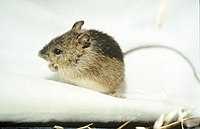Zapodidae
This article needs additional citations for verification. (July 2007) |
| Jumping mice Temporal range: Middle Miocene - Recent
| |
|---|---|

| |
| Zapus hudsonius preblei | |
| Scientific classification | |
| Kingdom: | |
| Phylum: | |
| Class: | |
| Subclass: | |
| Order: | |
| Family: | |
| Subfamily: | Zapodinae Coues, 1875
|
| Genera | |
Jumping mice (subfamily Zapodinae) are a group of mouse-like rodents in North America and China.
Although mouse-like in general appearance, these rodents are distinguished by their elongated hind limbs, and, typically, by the presence of four pairs of cheek-teeth in each jaw. There are five toes to all the feet, but the first in the fore-feet is rudimentary, and furnished with a flat nail. The tail makes up for 60% of its body length and is used to gain balance while bounding. The cheeks have pouches. The Sichuan jumping "yeti" mouse (Eozapus setchuanus) from China can be identified by the ‘Y’ marking on its belly.
Jumping mice live in wooded areas, grassy fields and alpine meadows. When disturbed, they start off with enormous bounds of eight or ten feet in length, which soon diminish to three or four; and in leaping the feet scarcely seem to touch the ground. they are nocturnal and generally live alone. The nest is placed in clefts of rocks, among timber or in hollow trees, and there are generally three litters in a season.
Classification
There are 5 species listed in Mammal Species of the World (2005).[1]
Subfamily Zapodinae, jumping mice
- Genus Eozapus
- Chinese jumping mouse, Eozapus setchuanus
- Genus Napaeozapus
- Woodland jumping mouse, Napaeozapus insignis
- Genus Zapus
- Meadow jumping mouse, Zapus hudsonius
- Western jumping mouse, Zapus princeps
- Pacific jumping mouse, Zapus trinotatus
References
- ^ Holden, M.E.; Musser, G.G. (2005). "Family Dipodidae". In Wilson, D.E.; Reeder, D.M. (eds.). Mammal Species of the World: A Taxonomic and Geographic Reference (3rd ed.). Johns Hopkins University Press. pp. 871–893. ISBN 978-0-8018-8221-0. OCLC 62265494.
